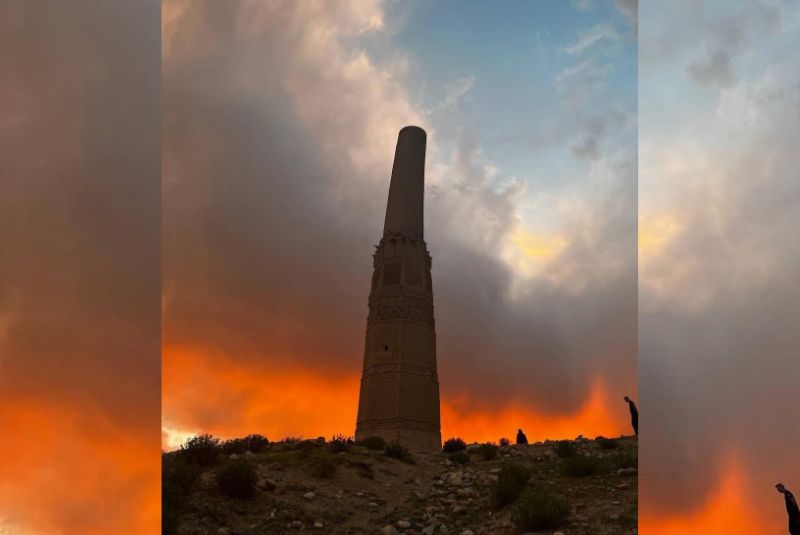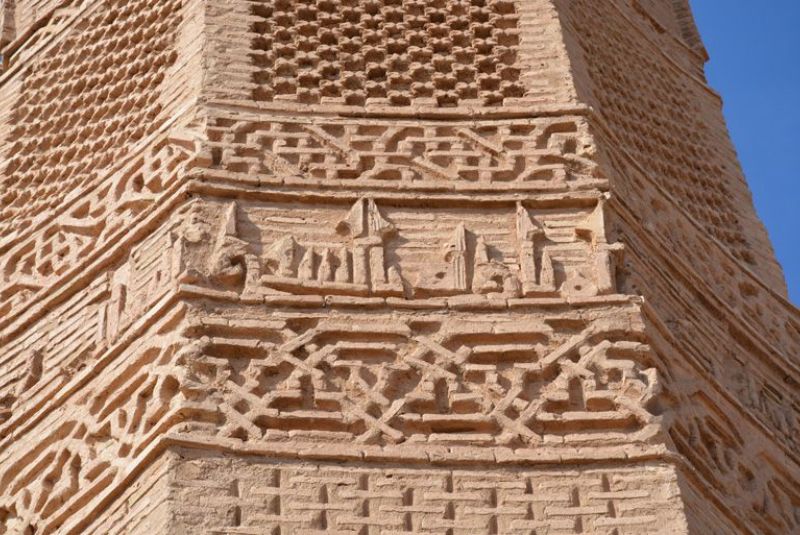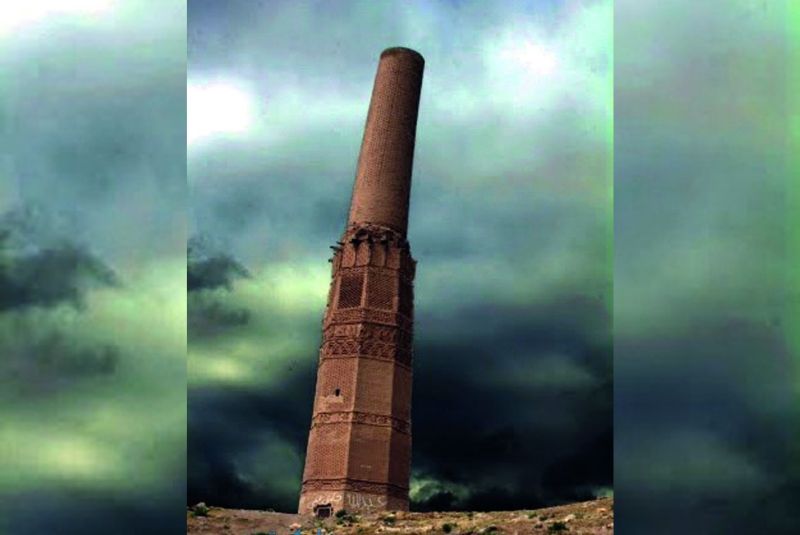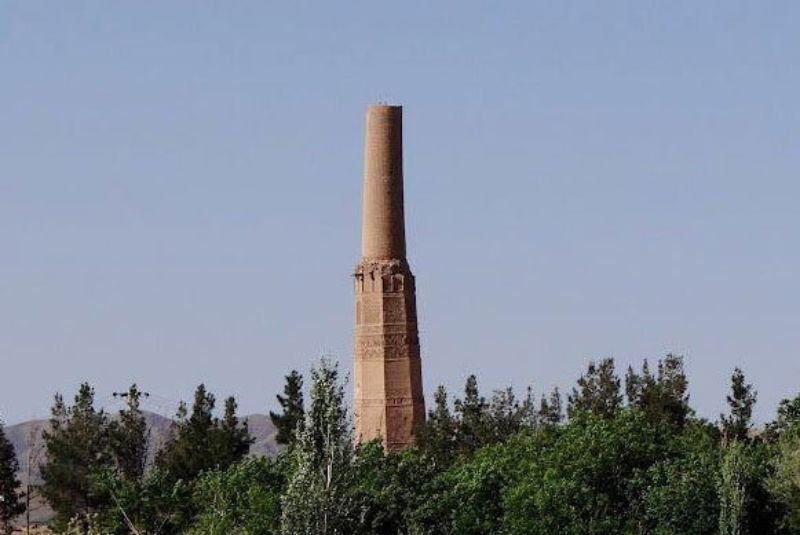Karat Tower: Iranian Lighthouse of the Desert
In the past, it may seem unbelievable how people managed to find their way and reach their destinations without modern navigation tools. However, this was made possible by landmarks and infrastructure like the Karat Tower in Razavi Khorasan.
The Karat Tower, often referred to as the "Iranian lighthouse of the desert," located in Taybad, is a significant historical monument dating back to the Seljuk era. It served as a crucial guidepost for caravans traveling from the Khorasan region towards the east.
The tower’s unique design, characterized by its brick structure and distinctive layered appearance, sets it apart from other minarets. It bears a striking resemblance to the famous Jam Minaret in Herat, Afghanistan. Though its Kufic inscription is no longer legible, the architectural style is unmistakably Seljuk.
Remarkably, the tower has withstood the test of time, including an earthquake that left it slightly tilted centuries ago. Despite this, the tower remains largely intact, except for some damage to its upper sections.
Today, the Kaarat Tower stands as a testament to the ingenuity of ancient architects and the critical role such structures played in the safe passage of travelers and traders across vast and challenging landscapes.
In this blog, we will delve into the fascinating architecture of Karat Tower, its location and how to get there. We will also explore the role of minarets in ancient Iran and discuss the Karat Village, nearby accommodations, and offer essential travel tips to ensure a smooth visit.
About Karat Tower
The Karat Tower is a historic minaret located 25 kilometers south of Taybad in Razavi Khorasan Province, Iran. Perched atop a relatively high hill next to a village cemetery of the same name, this impressive structure stands 25 meters tall with a base circumference of 20 meters.
Visible from a distance of 8 kilometers, the Karat Tower served as a crucial guidepost for caravans and traders navigating the ancient trade routes. Its distinctive multi-tiered design sets it apart from other minarets, bearing a striking resemblance to the Jam Minaret in Herat, Afghanistan.
Registered as a national monument of Iran in 1931, the Karat Tower consists of a two-part structure. The lower section is octagonal, while the upper section is cylindrical, showcasing the architectural style of the Seljuk era.
The tower's strategic location along one of the main branches of the Khorasan highways, which once connected Qaen to Khaf, Taybad, and Herat, underscores its importance. The brick inscriptions in Kufic script further attest to its ancient origins, dating back to the Seljuk period or even earlier.
Karat Tower or Leaning Tower of Pisa?

The Karat Tower, with its top section leaning due to an earthquake, often reminds visitors of Italy’s Leaning Tower of Pisa. Although the tilt of the Karat Tower is a result of an earthquake rather than intentional design, it underscores the remarkable skill of ancient architects.
The fact that this historic structure has remained standing despite the earthquake and its tilt highlights the durability and ingenuity of its builders, drawing a parallel to the renowned Leaning Tower of Pisa in terms of architectural resilience.
The Role of Minarets in Ancient Iran
"Mil" or "minarets" in Iran are towering structures erected alongside roads, designed to be visible from great distances to guide travelers. Historically, fires were often lit atop these edifices during the night, illuminating the path for nocturnal caravans.
This practice lends insight into the term "minaret," derived from "manareh," meaning "place of light" or "fire." Originally, these conical columns served as markers, indicating distances based on the ancient unit of measurement called "mil."
Over time, the term evolved, and any commemorative structure resembling a tower or minaret came to be known as a "mil." These architectural marvels not only facilitated navigation but also stood as testaments to the ingenuity of ancient engineers. The Karat Tower is a prime example of such a structure, embodying the rich history and functional design of mils that once punctuated the vast landscapes of Iran.
The Karat Village and Its Significance
Karat Village, located 52 kilometers south of Taybad on the road to Khaf, has historically held great significance due to its strategic location along an ancient route.
This village is not only home to the Karat Tower but is also close to a significant archaeological site, believed to be the original settlement of the Karat area. The village’s connection to the Karat Tower adds to its cultural and historical value, making it an essential mention in any discussion about the region.
In the vicinity of Karat Village lies the ruins of a stone caravanserai named Robat, situated just a short distance from the tower and on the other side of the Taybad-Khaf road. This caravanserai once served as a resting place for caravans and travelers passing through the area.
Architectural remnants suggest that the entrance of the caravanserai featured a covered archway leading to a central courtyard, with a stone cistern used for supplying water to the caravans and their animals.
Scattered pottery shards around this stone caravanserai indicate continuous habitation from the Seljuk period to the Timurid era, reinforcing the historical importance of Karat Village as a key location on the ancient trade routes of Khorasan.
Architecture of the Karat Tower

The Karat Tower, constructed during the Seljuk period in the 5th century AH (approximately 1106 AD), is a striking example of Seljuk architecture. Although today it stands as a solitary minaret, its design features suggest that it may have originally served as a call-to-prayer tower, with a balcony at its top for this purpose. Additionally, its elevated position on a hill indicates that it functioned as a guide for caravans or a desert lantern in ancient times.
The tower's structure is two-part: the lower section, or base, is an 8-sided polygon, standing 15 meters tall, while the upper section is cylindrical and 10 meters in height. Over time, the base has shifted and cracked due to an earthquake, causing the 15-meter structure to lean precariously to the west.
Architecturally, the tower features intricate brickwork and remains of a Kufic inscription, showcasing typical Seljuk design elements. The entire structure is built from brick, with mortar made of sand and gypsum.
The lower part of the tower includes remnants of a crenellated parapet and parts of the wooden supports that once adorned it. A western-facing doorway provided access to this parapet.

Although the Kufic inscription around the middle of the tower has been significantly damaged by natural elements, its initial phrase reads: "Bismillah, the order to build this minaret was given by the Sheikh..."
The tower’s exterior is also adorned with geometric brick patterns and decorative brickwork, including remnants of a crenellated parapet. This type of brick decoration is emblematic of the Seljuk period, reflecting the architectural sophistication of the time. Nearby, artifacts such as pottery indicate the area's historical significance and its role in the Seljuk civilization.
Location of Karat Tower
The Karat Tower is located in Razavi Khorasan Province, 25 kilometers south of Taybad, near the Iran-Afghanistan border. This historical monument stands beside a cemetery named Karat, adding to its intriguing and somewhat solemn setting.
The tower’s proximity to major cities highlights its strategic importance in the region; it is approximately 258 kilometers from Mashhad and 93 kilometers from Torbat-e Jam. Its location atop a relatively high hill allows it to be visible from miles away, serving as a beacon for travelers and traders on the ancient Silk Road.
The Karat Tower's position near the border also underscores its historical role in marking safe passages for those journeying between Iran and Afghanistan, making it a significant landmark in the region.
How to Get to the Karat Tower

To visit the Karat Tower, you can start your journey by plane or train to the nearest city with a railway station or airport. From there, you can take a bus or taxi to reach the tower.
If you prefer a more direct route, intercity buses or a personal vehicle are also convenient options for traveling to the Karat Tower. This way, you won't need to switch transportation modes during your trip, making the journey simpler and more efficient.
Best Time to Visit the Karat Tower
The best times to visit the Karat Tower are during the spring and autumn. These seasons offer ideal weather conditions for exploring Taybad and its surrounding attractions, including the Karat Tower. During these times, temperatures are pleasant, making your visit comfortable and enjoyable.
Nearby Amenities
Unfortunately, there are no specific amenities directly adjacent to the Karat Tower. Visitors should plan ahead and acquire all necessary supplies from the nearest village or city before heading to the site. This lack of facilities means that the tower remains a remote and historical destination, accessible primarily for those prepared in advance.
Essential Items for Your Visit
Given that the Karat Tower is situated alongside a road, specialized equipment is not required for your visit. However, a sunny day could necessitate a few practical items. Bring along a hat, sunglasses, and sunscreen to protect yourself from the sun.
Additionally, make sure to dress appropriately for the season, as weather conditions can vary. Comfortable clothing and footwear are recommended to ensure an enjoyable visit to the historic site.
Accommodation Near the Karat Tower

If you're planning to explore the Karat Tower and other attractions in the region, you will find a range of accommodation options in the vicinity. For a unique experience, consider staying at eco-lodges such as the Derjeh Eco-Lodge in the picturesque village of Pashtah. These lodgings offer a chance to immerse yourself in local culture and enjoy the natural beauty of the area.
Currently, there are limited accommodation options directly near the Karat Tower. Therefore, it's essential to review available lodging in nearby towns or villages before your trip. This preparation will ensure a comfortable stay and allow you to fully enjoy your visit to the tower and its surrounding attractions.
Tips for Visiting the Karat Tower
- Check the Weather: Ensure a sunny day for a pleasant visit. Bring sunglasses, sunscreen, and a hat for sun protection.
- Wear Comfortable Clothing: Dress in layers suitable for the season and wear comfortable shoes for walking.
- Bring Water and Snacks: Since there are no facilities nearby, carry enough water and snacks for your trip.
- Plan Your Route: Familiarize yourself with the route to the Karat Tower and nearby towns for accommodation and supplies.
- Explore Nearby Villages: Consider visiting nearby villages like Pashtah for local culture and unique accommodations.
- Respect the Site: Follow local guidelines and respect the historical significance of the Karat Tower.
- Photography: Bring a camera or smartphone to capture the tower’s unique architecture and surrounding landscape.
- Travel Light: Only bring essentials as there are no amenities at the site.
- Timing: Visit during daylight hours to fully appreciate the tower’s details and surrounding scenery.
- Local Guides: If possible, hire a local guide for insights into the tower’s history and architecture.
- Prepare for Heat: If visiting in summer, carry a cooling towel and dress in light fabrics.
- Check Accessibility: Verify the tower’s accessibility and any travel advisories before your visit.
- Stay Hydrated: Drink plenty of water to stay hydrated, especially if exploring in hot weather.
- Respect Local Customs: Be mindful of local customs and traditions when interacting with locals.
- Advance Booking: Book accommodations in advance, as nearby lodging options are limited.
Bottom Line
The Karat Tower, located in Taybad, Razavi Khorasan, is a remarkable remnant of the Seljuk era, serving as a crucial guidepost for ancient caravans. Often dubbed the "Iranian lighthouse of the desert," this 25-meter-tall tower stands out with its unique multi-tiered design and historical significance.
Despite sustaining damage from an earthquake centuries ago, the Karat Tower remains a testament to ancient architectural ingenuity. Its location, visible from afar and near the Iran-Afghanistan border, underscores its strategic role in guiding travelers.
Visiting the tower offers a glimpse into Iran's rich history and architectural prowess. For a smooth visit, plan your trip during spring or autumn, bring essential supplies, and consider nearby accommodations for a complete experience.
Share your story!
Comment below and let us know about your Experience.
Your story inspires others!


Comment
Leave a Comment